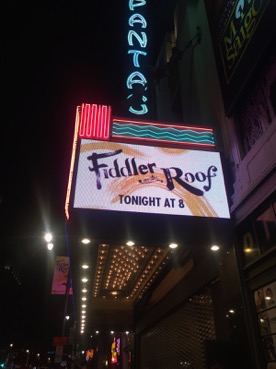Fiddler On the Roof: Same Religion, Different Tradition

Courtesy of Carlisle West ’21
May 20, 2019
Ever since my early childhood, I have been raised to recognize and take pride in my Jewish heritage. My mother, who is also Jewish, has taught me the fundamental teachings, history, and practices of our faith that date back to my Ukrainian ancestors in the late 1800s. My ancestors were Orthodox Jews, some of which were able to escape to America before Hitler’s reign, while others stayed and died in the concentration camps.
To provide further insight into our family history and origins, my mom has relied on movies and literature to teach me about the lifestyle and traditions of our Ukrainian ancestors. One movie, in particular, has resonated with me for the majority of my life: Fiddler On the Roof. This film follows the story of Tevye, a poor milkman who lives with his wife and five daughters in a small town in Imperial Russia in the early 1900s. He struggles to maintain his Jewish faith and tradition in a time of change, due to the dangerous threats of the Tsar on the Jewish people. He compares his struggles to a fiddler on a roof, a person who always has to live carefully on the edge without losing control. I have always felt so connected to this movie because I felt that I was similar to Tevye; we both live in a time of change – dangerous, unprecedented times – where we question our religious standards and faith. We both feel that while our religion is a major component of our identity, it can also define us in ways others do not like and cause us to feel like a target. Therefore, it remains one of my favorite movies because it teaches me about the history of my ancestors and teaches me about the importance of my Jewish identity.
My enthusiasm for the movie was no surprise to my mom; she had also grown up watching the movie with her family. As a special Christmas gift, my mother surprised my entire family with tickets to see Fiddler on the Roof: The Musical at the local Pantages Theater. I counted down the days until I could see the actors and actresses dancing and singing the songs that I had sung and danced to so many times in my living room. The day finally came April 26th when I was finally able to stand under the Pantages sign that read in glowing letters, “Fiddler On the Roof: The Musical.”
Once the musical began, I immediately could not stop singing along. My heart warmed with happiness, just like I did as I watched the movie for the first time. As Tevye sang with passion about the Jewish tradition in his quaint little town, I realized that Jewish tradition had undergone a major change between the 1900s and now. For example, it used to be sinful to marry someone who was not of the Jewish faith; in fact, your parents would disown you, pretend you were dead, and never speak of your name again. This can be shown in Fiddler On the Roof, where Tevye must disown one of his daughters after she marries a Russian man who is not Jewish. He later struggles to disown her and breaks down into tears as he laments about how he will never see his daughter again. However, thanks to the portrayal of interfaith relationships in the media, this tradition has changed over the years, and now, Jewish culture is more accepting towards these relationships. My mother is a Jewish woman married to a Christian man, and I could not be happier about the fact that they were both able to maintain their own faith while having respect for one another’s. Through being exposed to new traditions as a family, we have learned to open our hearts and accept everyone, like my father. Despite his Christian background, my father was still married under a chuppah (a Jewish wedding canopy) and has learned Jewish prayers in Hebrew.
Now more than ever, I believe it is extremely important for people to watch Fiddler On the Roof. The film’s lessons can apply to the lives of everyone, not just Jewish individuals. We can use the media and literature today to encourage and inspire others to strive to coexist in a racially, religiously, and ethnically diverse world. In modern society, we are constantly surrounded by mass destruction and increasingly frequent acts of violence against members of the Jewish community. It feels like the fiddler is beginning to lose his footing on the roof. Therefore, society must regain its footing on the roof, and regain its footing on the world.


